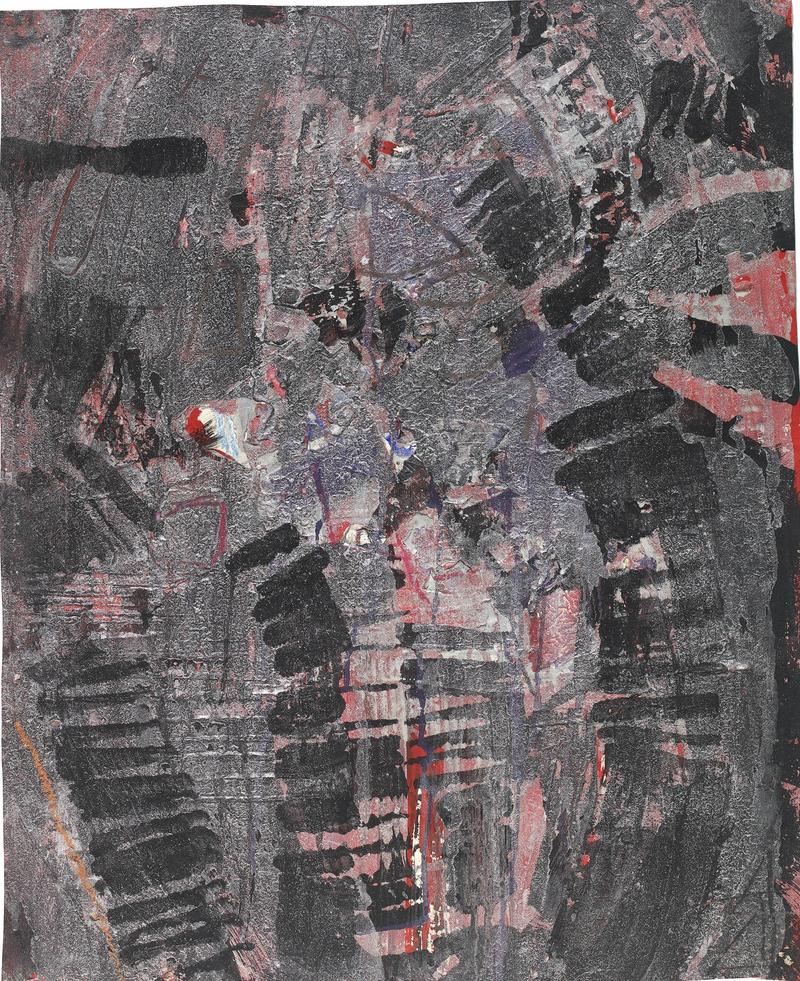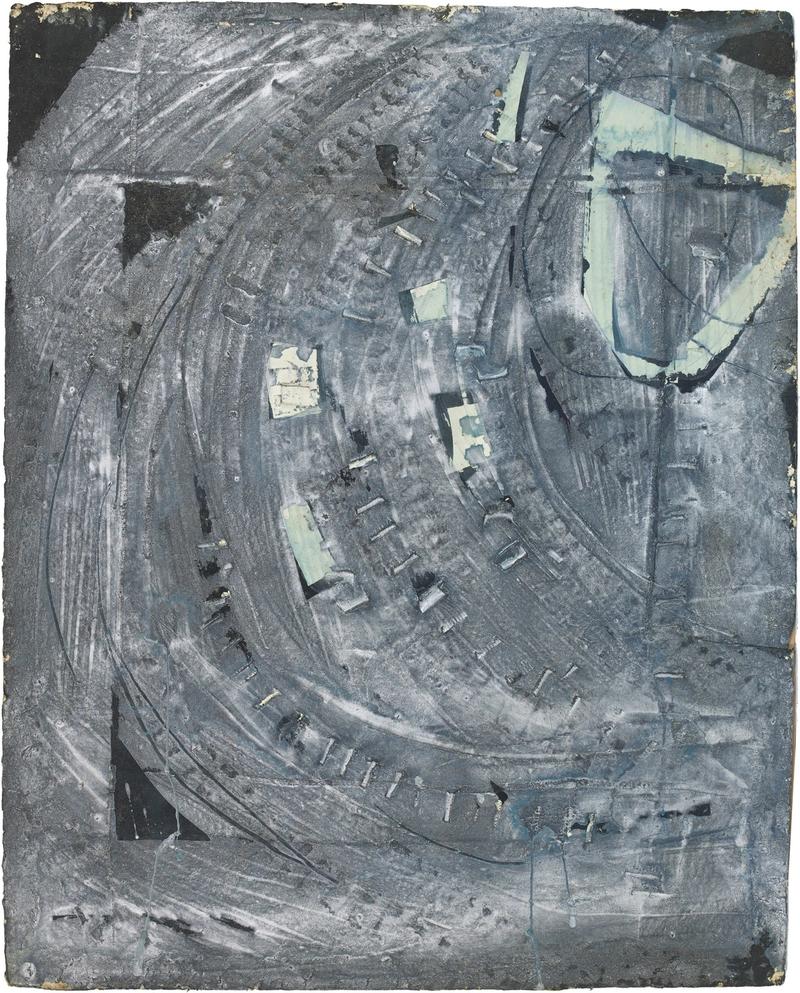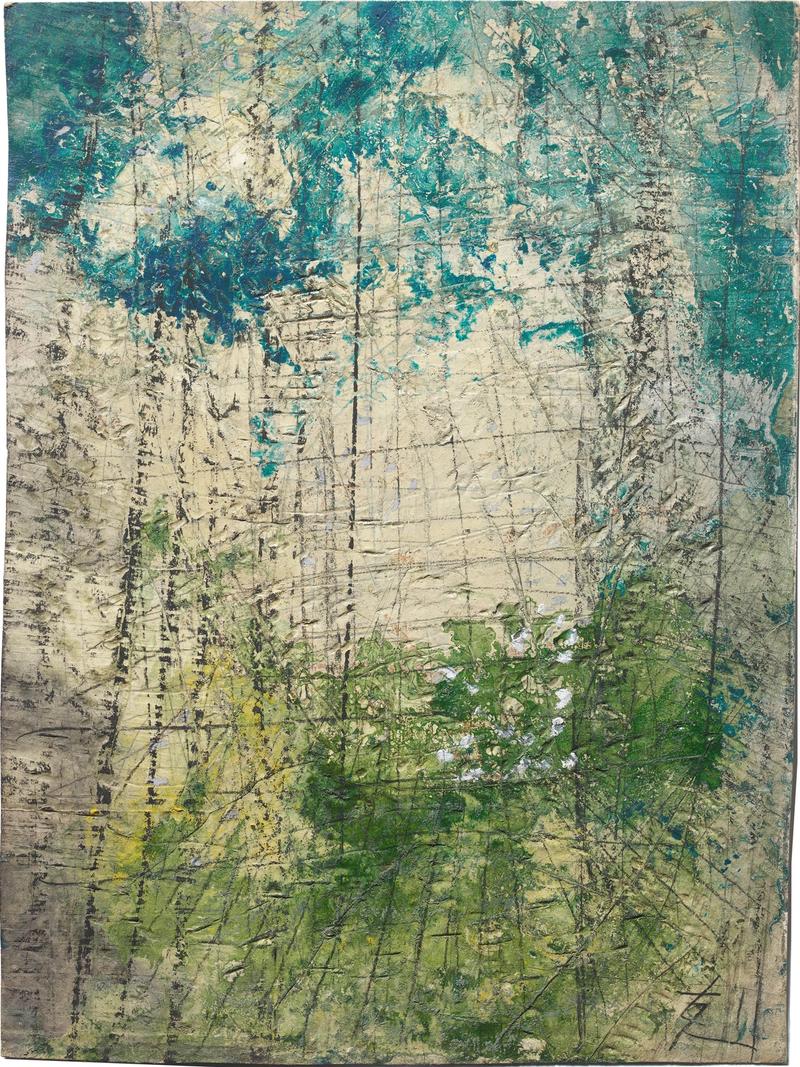Suda Kokuta
1906 to 1990
Japan

Biography
Like so many artists Kokuta Suda was passionate about art from a very early age. His dream of becoming a successful artist was not shared by his father who did not support Suda’s choice of carrier. However during his teen years Suda suffered some issues with his kidneys which left him bed ridden for many months giving him time to pursue his passion. His illness was life threatening and this experience haunted him for the rest of his life leaving Suda physically weak and insecure.
Despite these adversities his will was strong and Suda dedicated himself to becoming an artist and applied to enter the Fine Art School Tokyo. He failed four times! This could be seen as a positive outcome as he could now work freely without the dogma of an old fashioned institution. He began to paint pieces of meat and became obsessed with the subject, painting it again and again over several years in an attempting to capture the essence of the flesh within his canvas. His search is said to be one for the quintessence of art and the goal was to impart emotion and soul into his work. He admired Van Gogh, Picasso and Modigliani but refused to copy any other artist and staunchly followed his own path.
At this time (Suda’s mid twenties) Japan was also going through a period of major modernisation. This process led by foreign influence introduced many new building materials to Japan, one of which was asphalt. Suda was fascinated by the new road surface and even tried to steal some, leading to an arrest and several hours at the local police station. The thick sticky texture inspired him and can often be seen in his work.
At the age of 27, he was visited by Manjiro Terauchi (1890-1964), an important and influential artist of the Western style. Terauchi had seen one of Kokuta's paintings of meat in a collective exhibition, and astonished by the power of the lines and texture, he convinced Suda to move away from this obsession and to paint other subjects. This meeting changed his life.
In 1935, Kokuta gained some success showing works at two major exhibitions, however, his close friend and colleague Sadakatsu Nagafuchi was not so lucky and was not chosen. This rejection led Nagafuchi to commit suicide and left Kokuta with a great sense of guilt as he believed it was partly his fault. This tragic episode had an enormous impact on him, taking him close to a nervous breakdown. It was at this difficult time that he met Soetsu Mineo (1860-1954), the chief abbot of Heirin-ji temple, a Zen Buddhist temple.
After this initial meeting, he visited the temple regularly and they had long and deep conversations about spirituality. Without really understand it, he discovered in Zen Buddhism a way to find the light. He was 29 years old and his mind began to open. Kokuta Suda always had the ability to express his negative experiences through his art and his new found interest in Zen Buddhism allowed him to evolve and to go to the next stage.
Soon after in his early thirties Suda began to win prizes and had a small following of collectors and also gained a patron who offered him a small stipend along with a small studio. While basic this support and freedom allowed him to develop his own personal style and to get closer to his goal of paintings which could enlighten people as he struggled to impart his soul directly on to the canvas in style different from any other artist.
Having met Soetsu, he began a serious study of the philosophy of Zen Buddhism which inspired Suda to paint numerous Buddhist images. The more he studied Buddhism, the stronger his interest became, leading him to visit temples in the Kansai region often. Eventually a priest offered him a mud-walled warehouse in Kannon-ji temple Nara and Suda used this as a studio and basic accommodation. He stayed for two years, spending his days painting the many important Buddhist artefacts held in the city. He was deeply attracted by the power of these sculptures and tried to express their vitality through his work.
During the Second World War Suda was forced to work in a factory for almost two years making it impossible to focus on his art. During this period, he composed poems as a substitute and continued to visit all the great temples in Nara, becoming more and more insightful. The war finally ended and Suda was free to paint again. Unfortunately it was around this time that his sponsor died leaving Suda without an income. Fortunately for him he was invited to become a part-time teacher at an elementary school which would provide him with enough money to live. He was amazed by the freedom of expression and creativity of the children. When he was teaching to older students, he pushed them to develop their own style, to be different from the others, insisting on the importance of individuality.
He also decided to join other artists in discussion groups in an effort to expand his horizons and in 1949, during an exciting and controversial art circle talk, the famous abstract painter, Saburo Hasegawa (1906-1957), suggested that Kokuta should study Asian philosophy and read the teachings of the monk Dogen (1200-1253), author of Shobogenzo (the essence of enlightenment). Apparently he found it to be the most difficult philosophical book he had ever read but was desperate to fully understand the ideas of the priest and so he read it repeatedly. By studying this book, it allowed him to look deeper into himself and to have a better understanding of the abstract qualities of Zen. A quality which he then tried impart into his own work which now shifted from representational to abstract inspiring him to express his inner thoughts into a concrete form. He was excited by this new way of expression and finally began to enjoy his life as an artist. The Shobogenzo which he studied for the rest of his life, served as a theoretical support for his abstract paintings.
In 1950, Kokuta wrote his first essay on art which focused on calligraphy. This was published in Shonobi (Beauty of Calligraphy) sharing some important ideas with its main contributor and close friend of Franz Cline, Morita Shiryu (1912-1998), the famous avant-garde calligrapher. By writing down his ideas, he steadily established his theory of abstract art. He thought that lines were a kind of global language and that they were effectively a self-portrait of the calligraphers themselves. His obsession for the quality of the line, his talent as a painter and his strong spirituality soon brought him recognition as an outstanding calligrapher.
In 1955, he was invited by his friend and fellow artist Yoshihara Jiro to join the new avant-garde group Gutai but he declined preferring to stay independent in his creative process.
His status as an artist in Japan rose and he was invited to show his work at overseas exhibitions. He represented Japan, at the 4th Sao Paulo Biennale in 1957, followed by the 11th Plemio Resonne International Art Exhibition of Italy and Houston USA in 1959 followed in 1961 by Carnegie, Pittsburg USA and Berlin, West Germany.
Suda focused on an abstract style and calligraphy for a further 20 years. He was never afraid to change his approach and continued to use the painful times of his youth as a powerful tool. When he came back to figurative representation in the 1970’s/80’s, a trace of abstraction remained on his canvas and he enjoyed to mix both styles. He also improved his knowledge and technique of calligraphy at this time and began using a thick young bamboo brush to express philosophical words with dynamic lines full of vitality.
In 1971, he was asked to illustrate a newspaper series entitled Going along the road which was written by the acclaimed author Ryotaro Shiba (1923-1996). The collaboration between the two was a powerful one and the series with its brilliant text describing life in Japan during the Showa Period accompanied by the inspiring illustrations was a huge success and formed the begging of a twenty year long relationship where the pair travelled extensively, first across Japan and then on to Korea, Mongolia, and Europe. In total Suda produced over 900 illustrations for the series, bringing him national recognition and further success.
Suda received a prize of honour from his home town of Fukiage 1976 he considered it as the biggest honour possible.
In the last year of his life, he said that he finally felt he had mastered his chosen mediums of oil painting as well as ink and 1989 he produced more than 500 works, putting all his final energy into this over.
He spent his last days drawing from his hospital bed. Before his death Kokuta Suda donated approximately 3000 works to several museums in Japan. He died on July, 14th 1990 after a life of single-minded dedication to the practice of art and the spiritual qualities within it.
Works by the artist can be found in the collections of: Hyogo Prefectural Museum of Art, Hyogo; Saitama Prefecture Museum of Modern Art; The National Museum of Art, Osaka; Iida City Museum of Art, Nagano; Osaka City; Sōgetsu Museum of Art; Miho Museum, Gangōji Temple, Nara; Saitama Museum of Modern Art; Jakushū Itteki Library, Oi; Kahitsukan Kyoto Museum of Modern Art, Kyoto; The Metropolitan Museum of Art, New York; L.A. County Museum of Art; Minneapolis Institute of Art; Freer Sackler, National Museum of Asian Art, Washington D.C.; Yale University Art Gallery, New Haven.
Selected Group Exhibitions:
1935 – 1949 Exhibited annually at Kofu-kai Art Association (often receiving awards), Tokyo Metropolitan Art Museum
1936 Break Time, Bunten (Ministry of Education Fine Arts Exhibition), Tokyo Metropolitan Art Museum
1939 Man reading a book, highest prize at 3rd Shin Bunten
1941 Young Man, 4th Shin Bunten
1942 Shinsho (Divine general. Buddhist term for twelve protectors of the faithful), highest prize at 5th Shin Bunten
1946 Front view of Tōdai-ji Temple, 2nd Nitten (Japan Fine Arts Exhibition), Tokyo Metropolitan Art Museum
1947 Pink Turban, highest prize at 3rd Nitten
1948 2nd Sin-ju Kai Exhibition, Nihonbashi, Mitsukoshi, Tokyo
Myōkō-kai Exhibition, the Asahi Art Gallery, Kyoto
Tenpyō-no Kai Exhibition and Tenseki -kai exhibition, the Kyoto Art Museum
1949 23rd Kokuten (National Exhibition) organized by Kokuga-kai (National Painting Association), Tokyo Metropolitan Art Museum. Exhibited annually at Kokutenbetween 1949-1982
1955 3rd Japan International Exhibition, Tokyo Metropolitan Art Museum
3rd Modern Art Meeting Group Exhibition - Modern Composition, exhibited at the Japan America Abstract Art Exhibition
1957 4th Sao Paulo Biennale, representing Japan alongside Inoue Yūichi
1959 11th Premio Risone International Art Exhibition, Risone, Italy (alongside Shiraga Kazuo)
The Houston Art Museum Exhibition, USA
1961 Metaphysical Reality, Carnegie International Modern Painting and Sculpture Exhibition, Carnegie Institute Pittsburgh
Japanese Contemporary Painting, Akademie der Kunst, Berlin
1963 Modern Art Movements – West and Japan, National Modern Art Museum, Kyoto
1965 9th Japan International Art Exhibition, Tokyo Metropolitan Art Museum
1966 7th Modern Japanese Art Exhibition, Tokyo Metropolitan Art Museum
1971 1st Hyogo Art Festival, Kobe, annually until 1975
Seven Artists Exhibition Hankyu, Osaka
1975 Four Abstract Artists alongside Shiraga Kazuo, Tsutaka Waichi, Motonaga Sadamasa, Hyogo Prefectural Museum of Art, Hyogo
1983 Modern Art Exhibition, The Atelier, Nishinomiya;
Shotten (Modern Artists Calligraphy Exhibition) Gallery White, Osaka;
5th Japan Shusaku Art Exhibition, Takashimaya, Nihonbashi, Tokyo;
Modern Art Exhibition by Award Receiving Artists, Ashiya;
Japanese and European Art Exhibition, Modern Art Museum, Wakayama
1989 Five Artists Exhibition, Sogetsu Art Museum, Tokyo;
Two Artsists Suda Kokuta and Kumagai Morikazu Exhibition, Matsuyama Gallery, Ehime
1990 Five Artists Exhibition, Shinsaibashi Univeristy Gallery, Osaka
1995 Invitation to Abstract Art, The National Museum of Art, Osaka
1997 The Twentieth Anniversary Exhibition: From The Ohashi Collection, The National Museum of Art, Osaka
1997 Ohashi Collection: Sengo Gendai Bijutsu no Doko, Nara Prefectural Museum of Art, Nara
1997 The World in Transition: Painting In Japan since 1945, Takaoka Art Museum, Toyama
2021 Suda Kokuta x Shiraga Kazuo, Amagasaki Culture Centre, Hyogo
Selected Solo Exhibitions:
1948 Suda Kokuta European Art (first solo exhibition) the Asahi Garo (Asahi Art Gallery), Kyoto
1950 Nihonbashi Mitsukoshi Department Store, Tokyo
1960 Form Gallery, Osaka
Nakabayashi Gallery, Bungei Shunju Gallery, Tokyo
1970 Hankyu Department Store, Osaka
1971 Gushō-ga (figurative painting) exhibition at the Hankyu Department Store, Osaka
1977-1979 Suda Kokuta Oil Painting at the Mitsukoshi Art Gallery, Tokyo
1982 Suda Kokuta – New Works Exhibition in the Gallery Ashiya, Hyogo
1983 Hideyama-do Gallery, Tokyo
Suda Kokuta Oil Painting Exhibition, Mitsukoshi, Nihonbashi, Tokyo
1984 Maruei Department Store, Nagoya
Tokyo Hideyamado Gallery, Tokyo
Suda Kokuta - My World exhibition Maruei Department Store, Nagoya
Suda Kokuta - My World exhibition, Mistukoshi, Nihonbashi, Tokyo
1986 Maruei Department Store, Nagoya
Mitsukoshi Matsuyama, Matsuyama City, Ehime Prefecture
1987Suda Kokuta selected works, Hoshino Gallery, Kyoto
Suda Kokuta 1987 Exhibition, Mitsukoshi, Tokyo
Suda Kokuta calligraphy exhibition, Mitsukoshi, Matsuyama
1988 Hankyu Department Store Osaka
Mitsukoshi, Matsuyama Department Store
Mariei Department Store, Nagoya
1989 Kaibundo Gallery, Kobe
Sumino Sekai-ten (The World of Ink Exhibition) Seibu Department Store, Osaka
60th Anniversary Exhibition, Hankyu Department Store, Osaka
Suda Kokuta 1970’s Retrospective, Nishinomiya Shoen Gallery
Suda Kokuta Exhibition, Mitsukoshi, Tokyo
1990 Suda Kokuta Works, Saitama Prefecture Museum of Art
Suda Kokuta Unknown World, Iida City Museum
1992 Hotobashiru seimei: gagyo 50-nen, Suda Kokuta ten [Surging life force: paintings from his 50-year career, Suda Kokuta exhibition], The Museum of Modern Art, Saitama and other venues
2000-1 Botsugo 10-nen seimei no kongen o motomete Suda Kokuta ten [Suda Kokuta 10th anniversary exhibition: in search for the origin of life], Umeda Hanyu, Osaka; Nihonbashi Mitsukoshi, Tokyo, and other venues
2006-7 Seitan 100-nen kinen Suda Kokuta ten: inochi no sanka [Exhibition commemorating the 100th anniversary of Suda Kokuta’s birth: anthem of life], Urawa Art Museum and other venues
2011 Gangoji no Suda Kokuta [Suda Kokuta in Gangoji], Gangoji temple, Nara
2020 SUDA Kokuta MANDALA, Higashi Osaka City Art Centre, Osaka; Paramita Museum, Mie
2023 Featured Suda Kokuta, The Museum of Modern Art, Saitama































